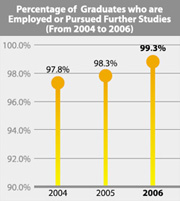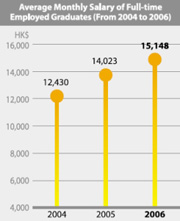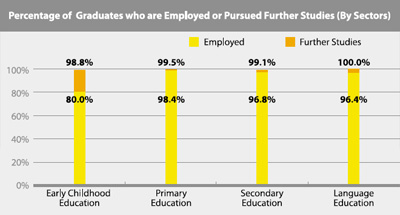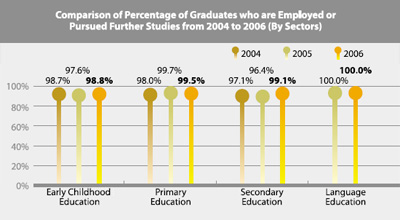Background Information
The survey was conducted between 29 September 2006 and 5 January 2007. Among the 921 graduates, 862 replied, representing a response rate of 93.6%.
Employment Rate
The percentages of 2006 graduates who are employed or pursuing further studies are:
£» Early Childhood Education: 98.8%
£» Primary Education: 99.5%
£» Secondary Education: 99.1%
£» Language Education: 100%
It is worth noting that the first cohort from the Language Education Programme in Chinese and English Language graduated in 2005. Graduates of this Programme have since been much sought after by schools. At the same time, in parallel with the government's policy to introduce the voucher scheme for kindergartens, many graduates of the Early Childhood Education Programme are seeking to enhance standards by continuing their academic pursuits.

The survey also revealed that the employment rate (including the rate of those pursuing further studies) among our 2006 graduates is the highest when compared to both 2004 and 2005 graduates. The figures are 99.3%, 98.3% and 97.8% for 2006, 2005 and 2004 respectively.
Salary Levels
In line with the employment rate, the salary level for 2006 graduates is also the highest in comparison to those who graduated in 2004 and 2005. The average monthly salaries for full-time graduate employees are $15,148, $14,023 and $12,430 for 2006, 2005 and 2004 graduates respectively. For 2006 graduates, this represents a rise of 8% in average salary levels when compared to 2005 and a rise of 21.9% when compared to 2004.

Conclusion
The consistently high employment rate of HKIEd graduates in recent years is testament to the quality of the teacher education programmes offered by the Institute. In the run up to the 3-3-4 education reform, the Institute expects to make a significant contribution to the education community, with its full range of undergraduate, Master and Doctor of Education programmes.



Application Figures Soar across the Board
Similar to the encouraging employment rate of our graduates, we also saw huge increases of 21.8% to 80% in the number of applications received for our undergraduate, post-graduate diploma and Master of Education programmes. As of late February 2007, the application figures for the various programmes were:
Post-Graduate Diploma in Education
A total of 898 applications were received, competing for 490 student places. The figure represents a steep increase of 80%, when compared with the 499 applications received at the same time in 2006.
Bachelor of Education
The programme received a total of 19,662 applications under the Joint University Programmes Admissions System (JUPAS), and 459 non-JUPAS applications, competing for 523 student places. The figures represent increases of 21.8% (16,145 in 2006) and 66% (276 in 2006) respectively, when compared with the applications received at the same time last year.
Master of Education
A total of 264 applications were received as compared to 200 applications received at the same time in 2006.
The soaring application figures provide further testimony to the quality of the Institute's programmes, and mirror the popularity of our graduates among school principals. 


